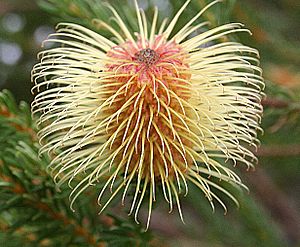Banksia ser. Abietinae facts for kids
Quick facts for kids Banksia ser. Abietinae |
|
|---|---|
 |
|
| B. pulchella (Teasel Banksia), a species in B. ser. Abietinae. | |
| Scientific classification | |
| Kingdom: | |
| (unranked): | |
| (unranked): | |
| Order: | |
| Family: | |
| Genus: | |
| Series: |
B. ser. Abietinae
Meisn.
|
Banksia ser. Abietinae is a special group, or "series," of plants within the larger Banksia genus. Think of it like a family tree where a series is a smaller branch. This group was first named by a scientist named Carl Meissner in 1856. Since then, scientists have changed their minds a few times about exactly which plants belong in this group.
Contents
How Scientists Classified This Group Over Time
Scientists often change how they group plants as they learn more. The Banksia ser. Abietinae group has been defined differently by various botanists over the years.
Early Ideas: Meissner's Classification
In 1856, Carl Meissner first described B. ser. Abietinae. He put plants into this group based on their leaves. Plants in this series had leaves that were either smooth-edged or had very small teeth, and their edges curled inwards. Meissner's group included plants like the B. pulchella and B. nutans.
Meissner's way of grouping Banksia plants was used until 1870. Then, another scientist named George Bentham created his own system and didn't use Meissner's series anymore.
A New Look: George's Classification
Many years later, in 1981, Alex George did a big study of Banksia plants. He brought back the B. ser. Abietinae group. George's definition was more specific. He included only those species with long, thin leaves that had curled edges and round-shaped flower heads. This meant some plants that Meissner had included were moved out, and new ones were added.
For example, George's group included B. sphaerocarpa and B. leptophylla. His classification helped organize the Banksia genus for many years.
Modern Science: DNA and New Discoveries
In 1996, Kevin Thiele and Pauline Ladiges used a method called cladistics to study Banksia plants. This method looks at how different features of plants are related to each other to figure out their evolutionary history. Their study showed that most of the plants in George's B. ser. Abietinae group were indeed closely related. They also added Banksia tricuspis back into the group.
More recently, scientists like Austin Mast have been using DNA information to understand how Banksia plants are related. DNA studies are like looking at the plants' genetic code to see their family connections. These studies suggest that the Banksia family tree might be very different from what was thought before. For example, some plants that were in B. ser. Abietinae, like B. nutans, might not be as closely related to the others as previously believed. Scientists are still working on a complete new classification based on these DNA findings.
See also
 In Spanish: Banksia ser. Abietinae para niños
In Spanish: Banksia ser. Abietinae para niños

